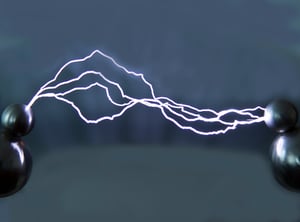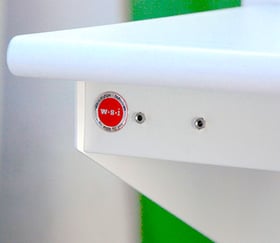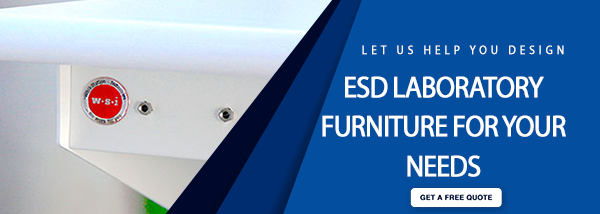Static electricity can be a problem for any lab. But for labs where weighing accuracy is critically important or where cleanroom specifications can mean the difference between a safe and dangerous workspace, managing static electricity becomes less of a nuisance and more of a high stakes priority.
If you’re considering laboratory furniture that can protect your lab space from static electricity, here are five things you need to know before you buy to ensure you get the most out of your investment.
1. Why ESD Is Dangerous
 Electrostatic discharge, or ESD, occurs when a build-up of static electricity occurs…often when two objects rub together and one object gives up electrons to another object. This causes one to become more positively charged while the other object becomes more negatively charged, creating a charge imbalance once the two materials or objects separate.
Electrostatic discharge, or ESD, occurs when a build-up of static electricity occurs…often when two objects rub together and one object gives up electrons to another object. This causes one to become more positively charged while the other object becomes more negatively charged, creating a charge imbalance once the two materials or objects separate.
These charges then may build up on an object’s surface until they find a way to be discharged. If this occurs in an industrial workplace or laboratories, the results can damage equipment, interfere with weighing accuracy and violate cleanroom specifications.
Worse, if laboratory technicians are working with flammable chemicals, a fire or explosion can occur. This was the case in 2016 when investigators found that an electrostatic discharge between a researcher and a gas storage tank containing hydrogen, oxygen and carbon dioxide likely contributed to an explosion at a University of Hawaii campus. The explosion resulted in the researcher losing one of her arms.
2. Types Of ESD Laboratory Furniture
ESD laboratory furniture can help prevent electrostatic discharges in a workspace. Here are three pieces to consider for your lab.
Workbench Surfaces
 ESD laminate surfaces, for example, are made of high pressure laminate with a carbon layer that dissipates any static that is generated. This type of surface also provides other benefits, such as resistance to staining and chemicals that include acetone, gasoline and 10% ammonium solutions.
ESD laminate surfaces, for example, are made of high pressure laminate with a carbon layer that dissipates any static that is generated. This type of surface also provides other benefits, such as resistance to staining and chemicals that include acetone, gasoline and 10% ammonium solutions.
ESD laminate surfaces can be paired with a laboratory table or workbench, which can be configured to include shelving, drawers and accessories to meet any storage needs.
ESD Chairs
To go with this workbench, an ESD chair also provides important protection. When a person sits in a chair, the contact between that individual’s clothes and the chair can generate a lot of electrostatic charge on clothing.
When you stay in contact with the chair, your body voltage stays low. If you lean forward so your back moves away from the chair back, or if you get up out of the chair, then you take the electrostatic charge with you. Your body voltage can rise very rapidly to a high voltage as the charge is separated from its counter charge on the chair.
If you’ve never noticed this occurring before, you’re not alone. People typically can’t feel a static discharge until about 2,000 volts or higher. However, ESD damage can occur to sensitive devices with as little as 1 volt of electricity. Most devices need about 100 volts before they are damaged beyond repair.
ESD chairs include fabrics and vinyls that are suitable for manufacturers of electronic products and those who have strict requirements in their labs. These types of chairs are manufactured with high-quality, non-flammable fabrics that are specifically designed to protect workers from electrostatic discharge problems.
Garments
Although not necessarily classified as lab furniture, clean room garments are another important tool in preventing electrostatic discharge. While clean room garments can come in a variety of materials, polyester is often used to create static dissipative fabric and is ideal for controlled environments where ESD is a concern.
3. Cost Of ESD Laboratory Furniture
 The cost of ESD laboratory furniture can vary by quality and manufacturer. ESD laminate work surfaces can be more expensive than other choices available. Lab managers should expect to pay about 15 to 30% more for an ESD product over a non-ESD product.
The cost of ESD laboratory furniture can vary by quality and manufacturer. ESD laminate work surfaces can be more expensive than other choices available. Lab managers should expect to pay about 15 to 30% more for an ESD product over a non-ESD product.
ESD lab chairs are typically more expensive than traditional lab chairs as well. However, it’s important to keep in mind that the lab chair is probably not the most expensive piece of equipment in your lab. If a static discharge occurs, your concern won’t be the cost of a chair … it will be the expensive piece of equipment that has been damaged.
Prevention is almost always better than replacement, and with the proper care, your investment can be preserved, along with the rest of your lab.
4. What Care Is Required
Although ESD laminate surfaces are durable, they do require some care to avoid damage, which could impact the ESD and chemical resistance properties of the countertop. However, the care required to maintain the integrity of the surface is similar to that of most other materials:
- Clean with a particle-free, non-abrasive damp cloth.
- Mild soap or a good ammonia detergent, water and a plain cotton rag should be used.
- Do not use abrasive cleaners or harsh chemicals.
- Avoid steel wool or any other material that may scratch the surface.
It’s also important to consult the manufacturer when surface punctures or deep scratches occur, since ESD protection may be compromised. Regularly check laboratory work surfaces for damage, wear and tear.
ESD work surfaces particularly should be tested on a regular basis with a megohmmeter, which can ensure the surface meets required standards for safety.
To care for ESD chairs, avoid harsh chemicals that can damage the material and regularly inspect for any damage or wear and tear. Most ESD chairs are easy to clean using a cotton rag and mild soap.
5. Other Features To Look For In Laboratory Furniture
 If ESD laboratory furniture is the right fit for your work space, that’s only the first step in determining the best furniture for your space.
If ESD laboratory furniture is the right fit for your work space, that’s only the first step in determining the best furniture for your space.
For example, ergonomics is an important consideration when selecting an ESD lab chair and workstation. More managers are embracing ergonomics because research shows companies that embrace ergonomics have healthier and happier workers, and from an investment standpoint, save more money over time.
Implementing ergonomics in the design of a workstation promotes natural body positions. This is the key to reducing workplace injuries because the workstation is designed to fit the worker rather than forcing the worker’s body to fit to the station.
Other considerations in the laboratory furniture you choose include:
- Storage and organization, including shelving and upper cabinets, pegboards that can hold tools, keyboard trays and articulating monitoring arms, and bin rails and panels that can hold parts and accessories
- Utility options, such as ductways, lighting, power poles and electrical power strips
- Capacity, taking into consideration what the workbench will be used for now AND in the future
Perhaps one of the most important things to know before buying ESD laboratory furniture, however, is whether the manufacturer you work with will customize the above features to meet your needs. The best manufacturers will provide you with the ESD protection you need while offering the customizable features necessary to keep productivity high.
For more information on how ESD can impact your operations, our article, How Furniture Can Contribute To A Static Free Workstation, offers tips for choosing ESD materials.


